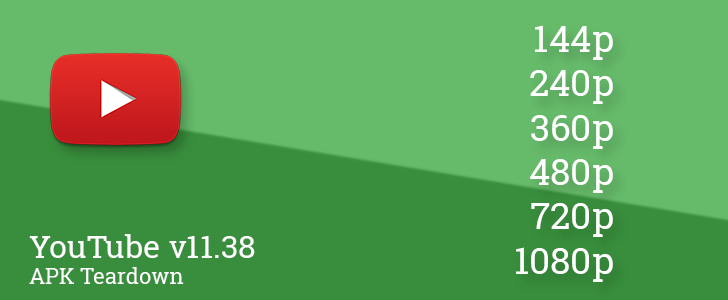Many of Google's most recent updates have been relatively light on features, turning instead towards cleaning up bugs. However, that doesn't mean there aren't still new things in the works. A couple of recent YouTube updates have been preparing some new features and we've got a teardown to reveal what users can probably look forward to in the future.
Teardown
Disclaimer: Teardowns are based on evidence found inside of apks (Android's application package) and are necessarily speculative and usually based on incomplete information. It's possible that the guesses made here are totally and completely wrong. Even when predictions are correct, there is always a chance that plans could change or may be canceled entirely. Much like rumors, nothing is certain until it's officially announced and released.
The features discussed below are probably not live yet, or may only be live for a small percentage of users. Unless stated otherwise, don't expect to see these features if you install the apk.
It's worth quickly pointing out that this is the YouTube app, so even though the features discussed below may not be live for me or anybody I've spoken with, it's fairly common that a small group of users will already have access as part of a test audience. In other words, it may be worth poking around to see if these are already live for you.
Double-tap to seek
YouTube has been experimenting with multiple methods of efficiently navigating videos. For large jumps, the seek bar is almost always the best way to skip several minutes or more, but it's not so good when a video is 2 hours long and you're trying to back up 30 seconds or so to re-watch the thing that just happened.
For shorter moves, there have been a few experiments with fast-forward and rewind functionality. The first attempt involved buttons in the player controls that you can tap or hold, and another later gave users the ability to simply drag a finger across the screen to speed up or slow down playback. Now the YouTube team is trying another method called "double tap to seek."
/xml/dogfood_prefs.xml
<SwitchPreference android:key="enable_double_tap_to_seek" android:defaultValue="false" />
The name spells out how this feature is used – once enabled, a user can double-tap to bring up a seek mode. But that's not entirely specific, at least not in terms of what it means to seek. I picture two possible scenarios. On the one hand, this might be an adaptation to the method mentioned above, wherein users first double-tap the screen, then begin dragging a finger to the right or left to fast-forward or rewind. It makes sense to add the double-tap as a prerequisite for skipping around because the former method could be prone to skipping around if a tap is misread as a drag.
The second theory is that the double-tap may activate a precision variant of the seek bar, similar to what the web interface offers if you click and drag up from the seek bar. This one also makes a lot of sense because it would allow users to find the right section of a larger video without blindly skipping around on the seek bar.
Either version would make it easier to get where you want to go in videos, but each serves a different purpose and solves different problems. Whichever it is, I certainly welcome either version. I just hope these things roll out a bit faster to all users.
For now, there are no other images or text to support this feature, especially no signs of a tutorial or hint screen to explain that it can be used. For now, I suspect this won't be launching right away, but there's no specific reason it couldn't launch fairly soon.
Set a max video resolution
We would all love to see every video in the highest resolution possible, but that's usually not a good idea when we're on a slow internet connection or pushing the limits of a data cap. YouTube is working on adding a setting that will allow users to set the highest video quality allowed while using mobile data.
The options include most of the major resolution buckets: 144p, 240p, 360p, 480p, 720p, and 1080p. There is also an 'auto' setting that likely leaves this decision up to the app based on network performance and possibly some other criteria, perhaps how much visual degradation there actually is between each setting. The only notable marks missing from the list are 1440p and 4K (i.e. 2160p). Strangely, there is a label for 1080p, but it's not included in the array of options. This could be an oversight, or it might be intentional if the 'auto' setting already defaults to 1080p.
strings
This will appear in the general settings screen of YouTube, so it shouldn't be hard to spot when it goes live. There probably won't be too many more resources to add for a feature like this, so it may already be live for some people. If it's not, I wouldn't be surprised to see it fairly soon, especially given the recent efforts to cut back on data consumption in constrained markets like India.
Download
The APK is signed by Google and upgrades your existing app. The cryptographic signature guarantees that the file is safe to install and was not tampered with in any way. Rather than wait for Google to push this download to your devices, which can take days, download and install it just like any other APK.
Version: 11.38.54

